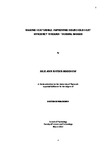Making Heat Visible: Improving household heat efficiency through thermal images.
| dc.contributor.supervisor | Auburn, Tim | |
| dc.contributor.author | Goodhew, Julie | |
| dc.contributor.other | Faculty of Science and Engineering | en_US |
| dc.date.accessioned | 2013-09-25T12:23:57Z | |
| dc.date.available | 2013-09-25T12:23:57Z | |
| dc.date.issued | 2013 | |
| dc.identifier | 10111991 | en_US |
| dc.identifier.uri | http://hdl.handle.net/10026.1/1956 | |
| dc.description | The full text file is under embargo under 09.09.15. | |
| dc.description.abstract |
Energy is largely invisible to users. It has been argued that employing technologies to visualise energy will assist people in conserving energy. Energy visibility interventions have largely focussed on appliance use and electricity consumption. This thesis aims to firstly explore whether making heat visible, using thermal images, promotes heat (and thereby energy) conservation. Secondly using a multiple method approach, it explores how. Five studies were employed. Study One and Three investigated whether using thermal images as a tailored antecedent intervention would promote energy conservation behaviours. The results confirmed that the images led to a reduction in Kg CO2 emissions attributed to domestic energy use. Study One and Three indicated that householders undertook more energy saving behaviours in relation to those aspects that were visible in the images. These actions were attributed to simple, energy saving behaviours such as proofing draughts. Study Two investigated how people make sense of the images and how behaviours are promoted by the images. Study two suggested that the images provide a unique medium through which factors which contribute to energy saving can be combined and reasoned by the viewer. It suggests the psychological factors in a pathway from prompt to behaviour. Study Four established that showing the images in an information presentation was not as effective when influencing participants’ ideas about energy conservation. Finally, Study Five explored participants gaze and demonstrated how features of the images, can attract the viewer. The novel contribution of this thesis is in establishing that ‘making heat visible’ through a tailored thermal imaging prompt can increase the likelihood of a householder taking simple energy saving actions, by providing a novel medium through which householders attend to heat and energy use. | en_US |
| dc.language.iso | en | en_US |
| dc.publisher | University of Plymouth | en_US |
| dc.subject | Pro-environmental behaviour | en_US |
| dc.subject | Energy | en_US |
| dc.subject | Visual Technology | en_US |
| dc.subject | Thermal Imaging | en_US |
| dc.subject | Interventions | en_US |
| dc.subject | Domestic Energy | en_US |
| dc.subject | Heat | en_US |
| dc.subject | Antecedents | en_US |
| dc.subject | Visibility | en_US |
| dc.subject | Psychology | en_US |
| dc.title | Making Heat Visible: Improving household heat efficiency through thermal images. | en_US |
| dc.type | Thesis | |
| plymouth.version | Full version | en_US |
| dc.identifier.doi | http://dx.doi.org/10.24382/3352 |
Files in this item
This item appears in the following Collection(s)
-
01 Research Theses Main Collection
Research Theses Main


